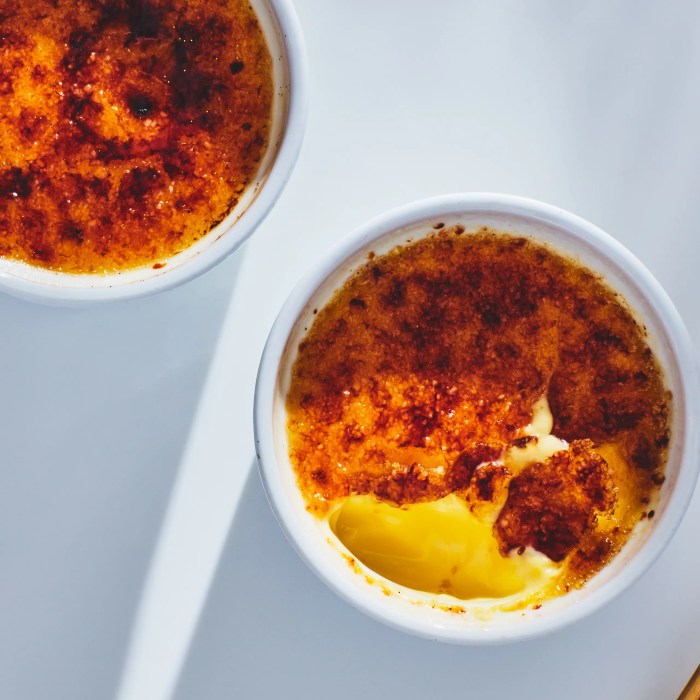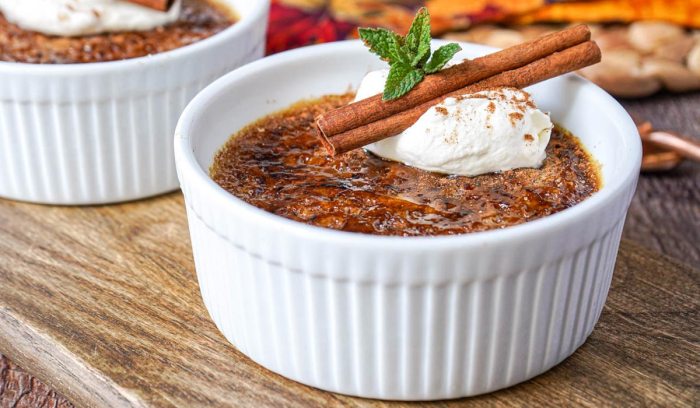
Crab brulee recipe – Indulge in the exquisite flavors of Crab Brulee, a dish that combines the savory richness of crab with the creamy indulgence of a custard. This culinary masterpiece tantalizes the taste buds with its unique texture and alluring presentation.
As we delve into the world of Crab Brulee, we’ll uncover its origins, explore the essential ingredients, and guide you through the step-by-step cooking process. Prepare to elevate your culinary skills and impress your dinner guests with this exceptional dish.
Introduction to Crab Brulee: Crab Brulee Recipe

Crab brulee, a culinary masterpiece with a rich history, traces its origins to the shores of France. Inspired by the classic dessert crème brûlée, this savory dish emerged as a unique and delectable combination of seafood and custard.
Crab brulee captivates the palate with its harmonious blend of flavors. The delicate sweetness of the custard complements the briny essence of the crab, creating a tantalizing symphony of tastes. Its velvety texture, achieved through meticulous cooking techniques, further elevates the dining experience.
Origins and History
Crab brulee is believed to have originated in the 18th century, when French chefs sought to elevate the humble crab dish. By incorporating techniques from the beloved dessert crème brûlée, they transformed crab into an elegant and sophisticated culinary creation.
Over time, crab brulee gained popularity throughout Europe and eventually made its way to the Americas. Today, it is a staple dish in many upscale restaurants and is often featured as a special delicacy at seafood-centric events.
Unique Flavor and Texture
Crab brulee is characterized by its distinctive flavor and texture. The custard, made with a combination of eggs, cream, and seasonings, provides a creamy and rich base. The crab, cooked to perfection, adds a briny and slightly sweet flavor that complements the custard beautifully.
The caramelized sugar crust, a signature element of crème brûlée, adds a touch of sweetness and a satisfying crunch to the dish. When the spoon breaks through the crisp exterior, it reveals the velvety custard and tender crab, creating a delightful contrast of textures.
Essential Ingredients and Equipment

Crab brulee, a delectable dish that combines the sweet and savory flavors of crab and custard, requires a specific set of ingredients and equipment to achieve its exquisite taste and texture.
The key ingredients for crab brulee include fresh crab meat, heavy cream, eggs, butter, and seasonings. Fresh crab meat provides the base for the dish, while heavy cream and eggs create a rich and creamy custard. Butter adds richness and flavor, and seasonings such as salt, pepper, and Old Bay seasoning enhance the overall taste.
If you’re looking for a seafood delicacy, check out this crab brulee recipe . It’s a creamy, flavorful dish that’s sure to impress. And for a vegetarian option, try this chicken of the woods recipe . It’s a meaty, satisfying dish that’s perfect for a plant-based meal.
Equipment
Preparing crab brulee requires specific equipment to ensure proper cooking and presentation. A food processor is essential for finely chopping the crab meat, while a whisk is used to combine the custard ingredients. Ramekins, small oven-safe dishes, are used to bake the individual crab brulees.
A kitchen torch is required to caramelize the sugar topping, creating the signature crispy layer.
Step-by-Step Cooking s
Crab brulee is a delectable dish that combines the richness of crab with the delicate texture of a creme brulee. Here’s a detailed step-by-step guide to help you prepare this culinary masterpiece:
Prepare the Crab Mixture
- Start by cleaning and flaking 1 pound of fresh crab meat. Remove any remaining shells or cartilage.
- In a large bowl, combine the crab meat with 1/2 cup of heavy cream, 2 large eggs, 1/4 cup of grated Parmesan cheese, 1/4 cup of chopped fresh chives, and a pinch of salt and pepper. Mix well until all ingredients are evenly incorporated.
Caramelize the Sugar
- Preheat your oven to 325°F (163°C).
- In a small saucepan, combine 1/2 cup of granulated sugar and 2 tablespoons of water. Bring to a simmer over medium heat, stirring constantly until the sugar dissolves and turns a light amber color.
Assemble the Brulees
- Generously butter six 4-ounce ramekins.
- Evenly divide the crab mixture among the prepared ramekins.
- Carefully pour the caramelized sugar over the crab mixture, ensuring it covers the entire surface.
Bake the Brulees
- Place the ramekins in a baking dish and fill the dish with hot water to reach halfway up the sides of the ramekins. This will create a water bath that helps the brulees cook evenly.
- Bake for 25-30 minutes, or until the brulees are set and the tops are slightly browned.
Chill and Serve
- Remove the brulees from the oven and let them cool for 10 minutes before refrigerating for at least 2 hours, or overnight.
- When ready to serve, run a knife around the edges of the ramekins to loosen the brulees. Invert them onto serving plates and enjoy the delectable combination of crab and creme brulee.
Variations
- For a richer flavor, use a combination of crab meat and lobster meat.
- Add a touch of Old Bay seasoning to the crab mixture for a spicy kick.
- Top the brulees with a dollop of caviar or creme fraiche for an elegant presentation.
- For a vegetarian version, replace the crab meat with artichoke hearts or mushrooms.
Presentation and Serving Suggestions

The presentation of crab brulee plays a crucial role in elevating its culinary appeal. Traditionally, crab brulee is served in individual ramekins, showcasing its golden-brown, caramelized crust. However, innovative chefs have explored various ways to present this dish, adding a touch of creativity to its presentation.
For a classic presentation, ramekins are preheated in the oven before pouring in the crab mixture. This ensures an even cook and a perfectly browned top. To add a modern twist, consider serving crab brulee in shot glasses or martini glasses, offering a chic and elegant touch.
Alternatively, you can opt for individual porcelain bowls, providing a sophisticated and upscale presentation.
Garnishes and Accompaniments
Garnishes and accompaniments can enhance the visual appeal and flavor profile of crab brulee. Fresh herbs, such as chives, parsley, or dill, add a pop of color and freshness. A sprinkle of grated Parmesan cheese adds a salty and savory touch.
For a touch of elegance, consider garnishing with edible flowers, such as nasturtiums or violets.
Accompaniments can complement the rich flavors of crab brulee. Crusty bread or crackers provide a crispy contrast to the smooth and creamy texture of the dish. A side of mixed greens with a light vinaigrette dressing adds a refreshing balance.
For a decadent touch, serve crab brulee with a dollop of caviar or smoked salmon.
Serving Temperatures and Occasions, Crab brulee recipe
Crab brulee can be served at different temperatures, depending on personal preference and the occasion. For a warm and comforting experience, serve crab brulee immediately after cooking, allowing guests to savor its creamy interior and caramelized crust. Alternatively, chilling crab brulee for a few hours or overnight allows the flavors to meld and develop, resulting in a more intense and complex taste.
Chilled crab brulee can be served as a refreshing appetizer or light lunch.
Crab brulee is a versatile dish that can be enjoyed on various occasions. It is an elegant appetizer for dinner parties or special events, adding a touch of sophistication to the menu. It can also be served as a light lunch or brunch option, offering a satisfying and flavorful meal.
Additionally, crab brulee can be prepared in advance, making it a convenient dish for busy weeknights or when hosting guests.
Additional Information and Tips

Crab brulee offers a unique blend of culinary delight and nutritional benefits. Rich in protein, omega-3 fatty acids, and vitamins, this dish supports overall well-being. The presence of zinc and selenium further contributes to immunity and antioxidant protection.
Troubleshooting Tips
- Cracked custard:Avoid overcooking or sudden temperature changes. Ensure the water bath is gently simmering and the oven is preheated to the correct temperature.
- Grainy texture:Strain the custard mixture thoroughly before baking to remove any lumps. Ensure the crabmeat is finely chopped or pureed for a smooth texture.
- Watery custard:Check the doneness by inserting a toothpick into the center. It should come out clean with just a few moist crumbs attached.
Cultural Significance and Regional Variations
Crab brulee has gained popularity beyond its origins in Maryland, USA. Regional variations have emerged, each showcasing local flavors and traditions.
- Chesapeake Bay Crab Brulee:The classic version, featuring a creamy custard topped with succulent blue crab meat.
- Louisiana Crab Brulee:Incorporates Cajun spices and a hint of heat, with crawfish or shrimp as an alternative to crab.
- New England Crab Brulee:Utilizes a slightly sweeter custard base and is often served with a drizzle of maple syrup.
Closing Notes
Crab Brulee stands as a testament to the boundless creativity of the culinary arts. Its versatility allows for experimentation with flavors and presentation, ensuring that every experience is unique. Whether you’re a seasoned chef or a home cook looking to impress, this dish will undoubtedly become a staple in your culinary repertoire.
Expert Answers
What is the origin of Crab Brulee?
Crab Brulee is believed to have originated in France, where it is known as “Crème Brûlée de Crabe.” It is a modern interpretation of the classic Crème Brûlée, incorporating the flavors of the sea.
Is Crab Brulee difficult to make?
While Crab Brulee may appear intimidating, it is surprisingly easy to make. With careful preparation and attention to detail, even novice cooks can achieve restaurant-quality results.
Can I substitute other seafood for crab?
Yes, you can experiment with different types of seafood. Lobster, shrimp, or scallops can be used as alternatives to crab, creating unique and flavorful variations.





